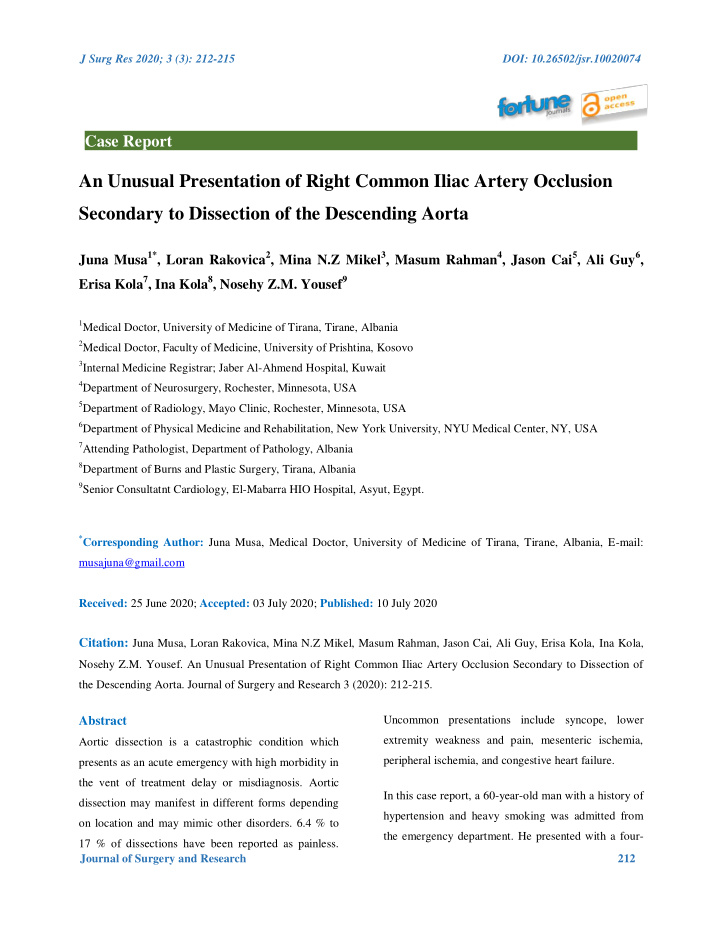



J Surg Res 2020; 3 (3): 212-215 DOI: 10.26502/jsr.10020074 Case Report An Unusual Presentation of Right Common Iliac Artery Occlusion Secondary to Dissection of the Descending Aorta Juna Musa 1* , Loran Rakovica 2 , Mina N.Z Mikel 3 , Masum Rahman 4 , Jason Cai 5 , Ali Guy 6 , Erisa Kola 7 , Ina Kola 8 , Nosehy Z.M. Yousef 9 1 Medical Doctor, University of Medicine of Tirana, Tirane, Albania 2 Medical Doctor, Faculty of Medicine, University of Prishtina, Kosovo 3 Internal Medicine Registrar; Jaber Al-Ahmend Hospital, Kuwait 4 Department of Neurosurgery, Rochester, Minnesota, USA 5 Department of Radiology, Mayo Clinic, Rochester, Minnesota, USA 6 Department of Physical Medicine and Rehabilitation, New York University, NYU Medical Center, NY, USA 7 Attending Pathologist, Department of Pathology, Albania 8 Department of Burns and Plastic Surgery, Tirana, Albania 9 Senior Consultatnt Cardiology, El-Mabarra HIO Hospital, Asyut, Egypt. * Corresponding Author: Juna Musa, Medical Doctor, University of Medicine of Tirana, Tirane, Albania, E-mail: musajuna@gmail.com Received: 25 June 2020; Accepted: 03 July 2020; Published: 10 July 2020 Citation: Juna Musa, Loran Rakovica, Mina N.Z Mikel, Masum Rahman, Jason Cai, Ali Guy, Erisa Kola, Ina Kola, Nosehy Z.M. Yousef. An Unusual Presentation of Right Common Iliac Artery Occlusion Secondary to Dissection of the Descending Aorta. Journal of Surgery and Research 3 (2020): 212-215. Uncommon presentations include syncope, lower Abstract extremity weakness and pain, mesenteric ischemia, Aortic dissection is a catastrophic condition which peripheral ischemia, and congestive heart failure. presents as an acute emergency with high morbidity in the vent of treatment delay or misdiagnosis. Aortic In this case report, a 60-year-old man with a history of dissection may manifest in different forms depending hypertension and heavy smoking was admitted from on location and may mimic other disorders. 6.4 % to the emergency department. He presented with a four- 17 % of dissections have been reported as painless. Journal of Surgery and Research 212
J Surg Res 2020; 3 (3): 212-215 DOI: 10.26502/jsr.10020074 hour history of pain and weakness in his right lower entry of blood into the outer two-thirds of the aortic limb. The patient was found to have a distal aortic media often precedes dilatation of the vessel and dissection complicated by right common iliac artery dilatation may or may not occur subsequently. occlusion, hence surgical correction was performed. Therefore, a more appropriate term would be “dissection of the aorta” [4]. The condition was promptly recognized and treatment was initiated without delay. The peak incidence of aortic dissection occurs between Keywords : Aortic Dissection; Lower Limb Ischemia; the sixth and seventh decades of life, with men Interventional Endovascular Management; Artery affected at least twice as often as women. In the Coronary Syndrome (ACS) United States, aortic dissection has an incidence of 5 to 10 cases per 100,000 per year and accounts for about 1.5 deaths per 100,000 males and 0.6 deaths per Introduction 100,000 females per year. About 30% of the patients Aortic dissection remains one of the most common with acute aortic dissection suffer from organ or limb disastrous events affecting the great vessels. Patients ischemia [5]. Lower extremity symptoms usually present with sudden onset excruciating chest accompanying dissecting hematomas of the aorta are pain, which is often described as ripping or shearing well described. Pacifico and Spodick reviewed 1751 and is frequently maximal at onset. Neurological cases of aortic dissection and reported that 10% of manifestations, such as acute ischemic stroke, spinal these had lower extremity symptoms. cord ischemia or peripheral nerve ischemia may be additional presenting features. Rarely, the dissection Case presentation may cause acute aortic regurgitation leading to myocardial infarction or cardiogenic shock [1]. A 60 year-old male presented to the emergency However, a dissection may not be initially suspected department with sudden onset of severe pain and when isolated lower extremity ischemia is the only weakness of the right lower limb for the past four presenting feature, leading to delayed diagnosis and hours associated with profuse sweating. He was a treatment. Only 10 cases (0.6%) of aortic dissections heavy smoker. He also had a history of hypertension were reported to have lower extremity ischemia with and had been on atenolol for one year. symptoms isolated to one or both lower limbs [2]. Clinical examination revealed an anxious, restless, Nicholls first described rupture of the inner coat of the pale, profusely sweaty, and obese gentleman. His heart aorta in the absence of rupture of the outer coat in rate was 68 beats per minute and regular. All 1728. It was not until middle of 1990s that a clear peripheral pulses were absent in the right lower limb. understanding of the natural history, pathogenesis and His blood pressures (BP) were 240/115 mmHg and etiology of aortic dissection evolved [3]. The term 234/112 mmHg on the right and left upper limbs “dissecting aortic aneurysm” is often used to describe respectively, and it was 178/98 mmHg in the left lower this acute catastrophic presentation. But strictly limb. BP was unrecordable in the right lower limb. speaking, the term “aneurysm” is erroneous because Examination of the right lower limb revealed 3/5 Journal of Surgery and Research 213
Recommend
More recommend